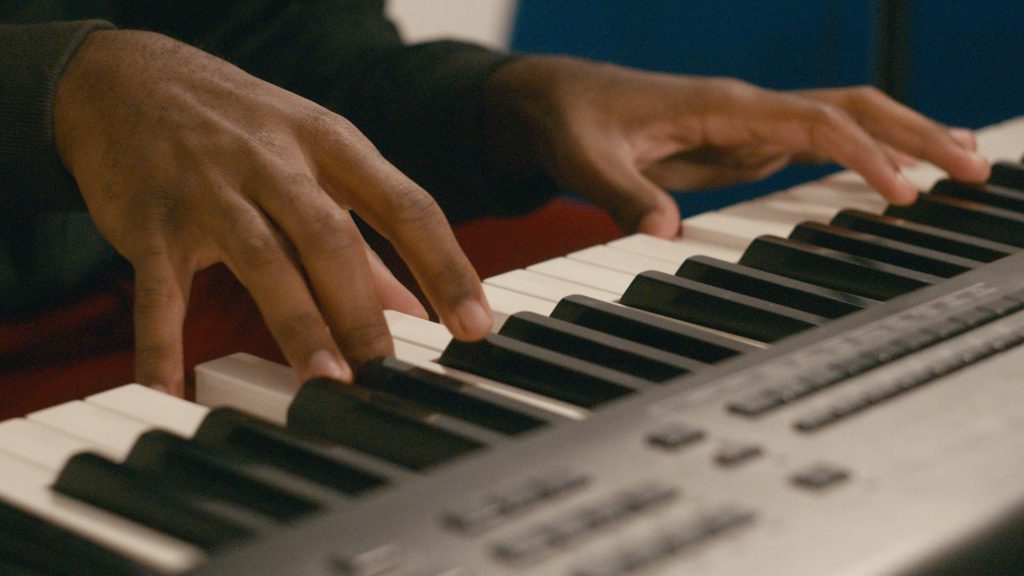It’s a debate that has left countless music enthusiasts scratching their heads: Are keyboards and pianos the same? At first glance, it might seem like an apples-to-apples comparison. Both instruments have black and white keys, they produce music, and at a distance, they might even look similar. But if you’re one of those who’s been embroiled in this debate or just an inquisitive soul, today’s your lucky day! Let’s jump straight into the heart of the matter.

The Tale of Two Instruments
Imagine for a moment that you’re at a grand concert. On one side of the stage, there’s a grandiose, elegant grand piano, and on the other, a sleek, futuristic keyboard. While both beckon you with the promise of musical magic, their histories, construction, and functions tell different stories.
A Stroll Down Memory Lane: The Piano’s Evolution
Pianos, beloved by many, have been around for centuries. Originating in the early 18th century, they evolved from instruments like the harpsichord. Picture composers like Beethoven and Mozart, crafting their symphonies on these. The main characteristic of a piano? Its acoustic nature. When you press a key, a hammer inside the piano strikes a string. This mechanism is what gives pianos their distinct, resonant sound.
A Glimpse into the Future: The Rise of the Digital Keyboard
Fast forward a few centuries, and enter the digital keyboard. A product of technological advancement, keyboards don’t rely on hammers and strings. Instead, they use electronic sound modules or synthesized methods to produce sounds. Born in the 20th century, they’ve quickly become a staple for modern musicians, thanks to their portability and versatility.
Digital Keyboards versus Acoustic Pianos: Breaking It Down
Now that we’ve gotten the history lesson out of the way, let’s get into the nitty-gritty differences.
Sound Quality and Authenticity
“Differences in sound quality” might be an understatement. An acoustic piano offers a depth and richness that is hard to replicate. The felt-covered hammers, striking strings, create organic overtones. Digital keyboards, however, come with pre-recorded sounds. While technology has allowed for some impressive sound samples in high-end keyboards, purists will argue there’s a noticeable difference.
Touch and Feel
If you’ve ever had the chance to transition between the two, you’d instantly recognize the “piano hammer action“. Pianos have weighted keys, offering resistance, mirroring the mechanism of the hammers and strings. Keyboards, on the other hand, can have “keyboard touch response“, simulating this feel, but it’s not a consistent feature across all models.
Portability and Modern Advancements
This one’s a no-brainer. The “advantages of digital keyboards” in terms of portability are hard to contest. They are lighter, compact, and some even run on batteries. Pianos, with their intricate internals, are bulky and difficult to move. Moreover, keyboards often come with additional features like recording options, varied instrument sounds, and even teaching tools.

Which Should You Choose?
To answer the burning question: No, keyboards and pianos are not the same. They serve different purposes and cater to varied audiences. For the budding musician on the go, a keyboard might be the practical choice. For the classical enthusiast or someone looking for authentic sound, a piano would be irreplaceable.
Remember, it’s not about which instrument is better, but which one is right for you. The beautiful thing about music is that it’s a journey, and whether you choose the path of the piano or the keyboard, it promises to be a melodious one.
A Look Into The Technicalities: Features & Functions
As we delve deeper into the heart of our musical investigation, it’s worth noting that beyond the apparent physical and auditory differences, there’s a world of technical distinctions between pianos and keyboards. This section might be particularly appealing to those gadget enthusiasts and tech-savvy folks out there.
Range and Versatility
Let’s start with the scope of notes. A standard piano, particularly a grand one, boasts 88 keys. That’s a total of seven octaves plus a minor third. It provides a wide array for composers and players alike. On the other hand, keyboards come in various sizes. Some mimic the 88 keys of a piano, while others might have as few as 25 keys. Thus, when considering “Features of modern keyboards”, one must take into account that the range can be a determining factor in one’s choice.
Keyboards also tend to have a leg up in terms of versatility. The ability to emulate other instruments (like drums, guitars, and even orchestral instruments) provides musicians with a full ensemble at their fingertips. And with the ongoing advancements in technology, some keyboards can even replicate the sounds of different piano types, from grands to uprights.
Maintenance and Durability
When comparing the “historical evolution of pianos” with keyboards, it’s evident that the former requires more care. Pianos, with their wooden components and strings, need tuning, regular cleaning, and sometimes even repairs to hammers and dampers. They’re sensitive to environmental changes, meaning humidity and temperature can affect their performance.
Keyboards, on the other hand, need minimal maintenance. Apart from the occasional dusting and ensuring they’re kept away from liquid, they’re pretty much good to go. Their digital nature makes them more resistant to environmental factors, too.
Cost Implications: Getting Bang for Your Buck
The cost of pianos vs. keyboards is a crucial factor for many. Acoustic pianos, given their intricate design and craftsmanship, can be a significant investment. Brands, size, and the type of piano (upright vs. grand) can create a vast price range.
Keyboards are generally more affordable, especially the entry-level ones. However, high-end keyboards, with advanced features and sound quality that closely mimics acoustic pianos, can also fetch a high price. It’s essential to note that with keyboards, sometimes, you’re also paying for additional features like recording capabilities, built-in lessons, and connectivity options.
Beyond Sound: The Emotional & Cultural Impacts
As we continue on this melodious voyage, it’s essential to recognize that instruments are not just about sound or technicalities; they often carry emotional, cultural, and symbolic weight.
The Cultural Significance of Pianos
Pianos have long held a place of reverence in many cultures. From the salons of 19th-century Europe to the jazz bars of 20th-century America, the piano has been a symbol of sophistication, art, and culture. It’s been the instrument of choice for legends like Chopin, Liszt, and Duke Ellington, echoing tales of eras gone by. In many homes, a grand or upright piano in the living room was (and in some places, still is) a status symbol, representing a family’s appreciation for the arts.
The Keyboard’s Role in Pop Culture
In stark contrast, keyboards, especially synthesizers, played a massive role in the pop culture explosion of the 80s and 90s. Think of iconic bands like Depeche Mode, Kraftwerk, or artists like Prince. Their unique sounds, derived from keyboards, defined a generation and represented a future-forward approach to music. Today, the keyboard’s portability and adaptability make it a staple in many music production setups, from hip-hop to electronic dance music.
Emotional Connections: Personal Stories & Memories
For many of us, our first encounter with music might have been through one of these instruments. Perhaps it was an old family piano, which held memories of gatherings, sing-alongs, or maybe it was a keyboard, a birthday gift, which marked the beginning of a musical journey. Instruments often become more than just objects; they transform into repositories of memories and emotions.
For some, the acoustic piano’s deep, resonant tones might evoke feelings of nostalgia, while for others, the synthesized beats of a keyboard might remind them of their youth or times spent with friends.
The Educative Angle: Learning & Skill Transfer
We often hear of the debate regarding the best instrument for beginners. Is it easier to transition from a keyboard to a piano or vice versa?
When we talk about “Skill transfer: piano to keyboard”, it’s worth noting that learning the basics – reading music, understanding scales, and finger placements – can be achieved on both. However, the weighted keys of a piano can offer a beginner a better understanding of touch and dynamics.
That said, keyboards often come with teaching tools, built-in lessons, and even light-up keys to guide novices. These features can be invaluable for self-learners or those who want a more interactive learning experience.
Conclusion
In our melodious journey, we unearthed that pianos and keyboards, while seemingly similar, are worlds apart. Rooted in rich histories, pianos echo classical sophistication, while keyboards epitomize modern versatility. Their distinctions span sound quality, design, functionality, cultural significance, and learning adaptability. Pianos offer an organic touch and profound cultural impact, while keyboards champion versatility, technological advancements, and a distinct cultural resonance in contemporary music. Both hold emotional value, marking personal milestones in our musical odysseys. Thus, while they serve different purposes and resonate with varied audiences, the true essence lies not in their differences but in the timeless music they create.
Frequently Asked Questions (FAQs):
1. Are keyboards and pianos the same instrument?
No, while both have keys and produce musical notes, pianos are acoustic instruments with hammers and strings, and keyboards are typically electronic, generating sound digitally.
2. Which has better sound quality: a keyboard or a piano?
Acoustic pianos offer a natural and resonant sound due to their strings and hammers. However, high-end digital keyboards can closely emulate this sound, with some even offering multiple piano sound samples.
3. Are keyboards more portable than pianos?
Yes, keyboards are generally lighter and more compact, making them easier to transport. In contrast, pianos, especially grand ones, are bulky and require careful moving.
4. Do pianos and keyboards have the same number of keys?
Standard pianos have 88 keys, but keyboards can vary. Some match the 88-key standard, while others might have fewer, ranging from 25 keys upwards.
5. Which is more suitable for beginners: a keyboard or a piano?
Both have merits. Pianos offer a better feel of touch and dynamics, which can be crucial for learning. Keyboards, however, often come with built-in lessons and tools beneficial for self-learners.

Experience is what matters at the end!!
Hi! This is Jacob Jay – founder of Keyboardgear.com! From childhood to adulthood, I’ve always remained passionate about IT, and the revolution in this industry, especially gaming on the PC can’t go out of my way. Since I’m an enthusiastic gamer, and I love to experience various gaming accessories, particularly mechanical keyboards, that really boost my gaming adventure manifolds. So, my nerve cells hit me to transfer my experiences into word form and share with others to identify the ideal keyboards perfectly fit for their gaming modes.
I know very well how hard it is to find the high-quality items available on the internet that ought to be exactly the same as seen as on the screen. But the counterfeiters have ruined the user’s trust. As I have passed all such situations, I’m obliged to deliver the genuinity and express the same as what I am saying.
So, now, I’m working on the mission to provide very helpful and frankly but trustworthy reviews and guides about various mechanical keyboards, mouses, and other gaming accessories as per my personal experiences and sound knowledge.
